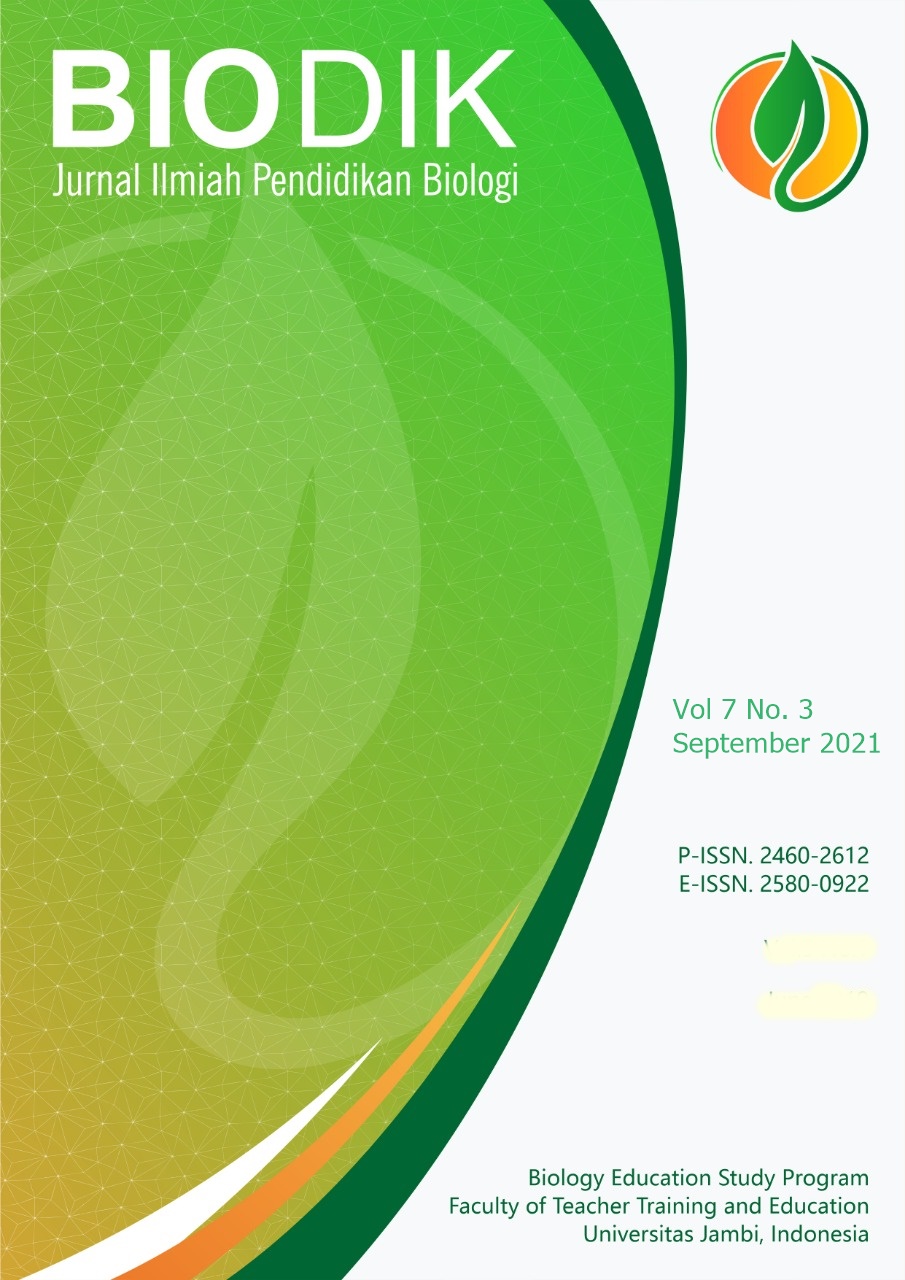Rekonstruksi DKL Materi Pteridophyta: Fenetik sebagai Sebuah Pendekatan
(Reconstruction of Practical Activity Design on Pteridophyta Materials: Phenetics as an Approach)
DOI:
https://doi.org/10.22437/bio.v7i3.13037Abstract
Education 4.0 focuses on improving 21st century skills, one of which is science process skills, especially communication skills on Pteridophyta material. However, the existing DKL as practicum support is not optimal. The purpose of this study was to analyze the quality of DKL on pteridophyta (ferns) materials used in schools in recent curricula covering aspects of curriculum relevance, competence, and knowledge construction. Then a trial was conducted on one of the DKL. The findings from the analysis and trials became the basis for the reconstruction of Pteridophyta DKL. The results of the research show that the existing DKL still has not developed higher-order thinking skills, and there are still few concepts formed. The results of the DKL reconstruction use a phenetic approach to make it more effective and representative according to the demands of the applicable KD and develop communication skills.
Abstrak.Pendidikan 4.0 berfokus pada peningkatan keterampilan abad ke-21, salah satunya keterampilan proses sains pada materi pteridophyta. Namun DKL yang ada sebagai penunjang praktikum belum optimal. Tujuan penelitian ini adalah untuk menganalisis kualitas DKL pada materi pteridophyta (tumbuhan paku) yang digunakan di sekolah dalam beberapa kurikulum terakhir, dengan menggunakan instrumen analisis kegiatan laboratorium meliputi aspek relevansi kurikulum, kompetensi, dan konstruksi pengetahuan. Lalu dilakukan uji coba pada salah satu DKL. Temuan dari analisis dan uji coba menjadi dasar rekonstruksi DKL pteridophyta. Hasil penellitian menunjukan bahwa DKL yang ada masih belum mengembangkan kemampuan berpikir tingkat tinggi, dan masih minimya konsep yang terbentuk. Hasil rekonstruksi DKL menggunakan pendekatan fenetik agar lebih efektif dan representatif sesuai tuntutan KD yang berlaku dan mengembangkan keterampilan proses sains.
Downloads
References
Abrahams, I., & Millar, R. (2008). Does practical work really work? A study of the effectiveness of practical work as a teaching and learning method in school science. International Journal of Science Education, 30(14), 1945–1969. https://doi.org/10.1080/09500690701749305
Ekselsa, R. A., Supriatno, B., & Anggraeni, S. (n.d.). BIODIK: Jurnal Ilmiah Pendidikan Biologi Rekonstruksi dan Pengembangan Lembar Kerja Siswa pada Materi Plantae Submateri Spermatophyta dengan Pendekatan Keterampilan Proses (Reconstruction and Development of Student Worksheets on the Spermatophyta Submater. https://online-journal.unja.ac.id/biodik
Hidayat, T. (2017). Menggairahkan pembelajaran taksonomi di kelas menggunakan metode fenetik. Tersedia: Https://Www. Researchgate. Net/Publication …, February. https://www.researchgate.net/profile/Topik_Hidayat/publication/313525815_Menggairahkan_pembelajaran_taksonomi_di_kelas_menggunakan_metode_fenetik/links/589d5c1192851c599c975c4d/Menggairahkan-pembelajaran-taksonomi-di-kelas-menggunakan-metode-fenetik.pdf
Laelasari, I., & Supriatno, B. (2018). Analisis komponen penyusun desain kegiatan laboratorium bioteknologi [Universitas Ahmad Dahlan, Kampus 3]. In JURNAL BIOEDUKATIKA (Vol. 6, Issue 2). https://doi.org/10.26555/bioedukatika.v6i2.10592
Lase, D. (2019). Pendidikan di Era Revolusi Industri 4.0 [STT BNKP Sundermann]. In SUNDERMANN: Jurnal Ilmiah Teologi, Pendidikan, Sains, Humaniora dan Kebudayaan (Vol. 12, Issue 2). https://doi.org/10.36588/sundermann.v1i1.18
Murni, R. L. F., Harlita, & Widoretno, S. (2017). Penerapan Guided Inquiry Learning untuk Meningkatkan Keterampilan Interpretasi Data Siswa Kelas XI IPA 4 Tahun Pelajaran 2016 / 2017 pada Materi Sistem Ekskresi Manusia. Proceeding Biology Education Conference, 14(1), 355–360. https://jurnal.uns.ac.id/prosbi/article/view/18812
Novak, J., Gowin, D., & Kahle, J. (1984). Learning How to Learn. Cambridge: Cambridge University Press. https://doi.org/10.1017/CBO9781139173469
Oktaviani, F., & Hidayat, T. (2015). Profil Keterampilan Berkomunikasi Siswa Sma Menggunakan Metode Fenetik Dalam Pembelajaran Klasifikasi Arthropoda. Jurnal Pengajaran Matematika Dan Ilmu Pengetahuan Alam, 15(1), 13. https://doi.org/10.18269/jpmipa.v15i1.288
Sisri, E. M., Anggraeni, S., Supriatno, B., Studi, P., Biologi, P., & Keguruan, F. (n.d.). BIODIK: Jurnal Ilmiah Pendidikan Biologi Analisis dan Rekonstruksi Lembar Kerja Siswa Materi Spermatophyta Dengan menerapkan Analisis Fenetik (Analysis and Reconstruction of Practical Work Spermatophyta Material By applying Phenetic Analysis). https://online-journal.unja.ac.id/biodik
Sofyan, F. A. (2019). Implementasi Hots Pada Kurikulum 2013. Inventa, 3(1), 1–9. https://doi.org/10.36456/inventa.3.1.a1803
Wahidah, N.S, Suptriatno, B, Kusumastuti, M. N. (2018). Analisis Struktur dan Kemunculan Tingkat Kognitif pada Desain Kegiatan Laboratorium Materi Fotosintesis. 7260(2), 70–76.
Downloads
Published
How to Cite
Issue
Section
License
Copyright (c) 2021 Pipin Puja Lestari, Sri Anggraeni, Bambang Supriatno

This work is licensed under a Creative Commons Attribution-NonCommercial-ShareAlike 4.0 International License.
Copyright Notice
Authors who publish with Biodik : Jurnal Ilmiah Pendidikan Biologi agree to the following terms:
- For all articles published in Biodik : Jurnal Ilmiah Pendidikan Biologi, copyright is retained by the authors and grant the journal right of first publication with the work simultaneously licensed under a Creative Commons Attribution-ShareAlike 4.0 International Licensethat allows others to share the work with an acknowledgment of the work's authorship and initial publication in this journal.
- Authors are able to enter into separate, additional contractual arrangements for the non-exclusive distribution of the journal's published version of the work (e.g., post it to an institutional repository or publish it in a book), with an acknowledgment of its initial publication in this journal.
- Authors are permitted and encouraged to post their work online (e.g., in institutional repositories or on their website) prior to and during the submission process, as it can lead to productive exchanges, as well as earlier and greater citation of published work (See The Effect of Open Access).

















